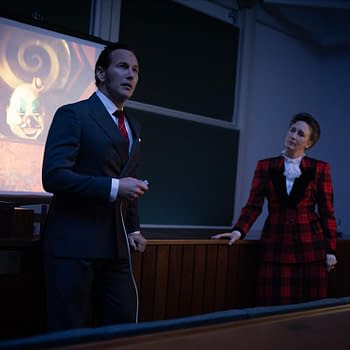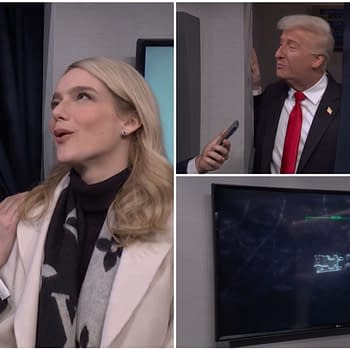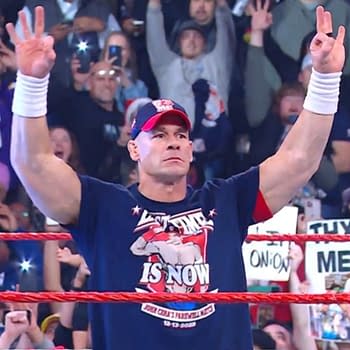Posted in: Movies, Recent Updates, TV | Tagged: anime, Attack On Titan, Biomega, Blame!, Comics, david cronenberg, entertainment, Freedom Wars, hideo kojima, japan, Knights of Sidonia, manga, metal gear solid, Space Battleship Yamato 2199, Tsutomu Hihei, tv
Knights Of Sidonia: The War Robots Of The Japanese Dreamtime – Look! It Moves! By Adi Tantimedh
Adi Tantimedh writes:
Knights of Sidonia, the 12-episode first season of the manga adapted from Tsutomu Hihei's hit manga series premiered this weekend as the first Netflix exclusive anime series. Amongst anime fans, this was one of the most anticipated shows of the year. It has been praised by no less than Metal Gear Solid creator Hideo Kojima for its committed hard science fiction ideas.
It's set thousands years in the future where Humanity lives on a giant colony moving through space, often attacked by giant Lovecraftian creatures they barely understand. Society has been effectively militarised and teenagers are trained in school to be pilots of giant robots to fight them. The hero is an outsider to this society who has exceptional piloting and combat abilities and may be the last, best hope of saving Humanity. But there are some secrets to uncover: the true nature of the leaders of society, and the hero's own identity is a mystery even to him even as the alien attacks intensify and pilots die faster than they can be replaced…
[youtube]https://www.youtube.com/watch?v=I31QP4SE3Gw[/youtube]
On the surface, this appears to be another space military series about teenagers piloting giant robots in an apocalyptic war against monstrous alien invaders. What makes this series interesting is it's from a manga by Tsutomu Nihei. His first mainstream success in the Shonen manga scene, the series is a departure from the darker, more adult stories he made his reputation on. Nihei had previously created posthuman cyberpunk sagas like Blame! and Biomega, which were set in far-flung post-Singularity futures where humans had been genetically and cybernetically altered to the point of barely fitting the definition of "human" anymore. His art style was dark, deliberately scratchy and messy to create an atmosphere of messy, sticky griminess with lightning-fast bouts of ruthless violence and a penchant for Cronenbergian body horror. To my mind, Biomega pushed the comics medium as far as it could go in its breakneck hard science cyberpunk action, light years beyond any other comic out there and still unsurpassed, moving at beyond the speed of the most frenetic video games let alone movies or comics. That's no surprise considering Nihei is, unusually for a Japanese gamer, a reputed fan of Western video games like Halo and Metro 2033.
I'd wondered how Nihei could possibly top himself after the intense craziness of Biomega and the answer seems to be that he can't. Instead, he seems to have taken a step back, possibly at the suggestion of his editors, and tackled the more conventional future space robot combat genre starring teenagers. He has also scaled back the roughness of his art to draw in a cleaner, smoother line to depict prettier people. This is a bit like asking a gourmet chef to make a cheeseburger. He makes a very good cheeseburger, but also puts in some very uniquely weird ingredients does strange things to the reader's brains.
So yes, the hero of Knights of Sidonia is a hapless, self-effacing dope that many current manga heroes are, instead of the supremely competent lone wolf action heroes of Nihei's previous series. He's surrounded by female classmates who have the hots for him. They pilot giant robots that fight for a militarised society as in many other series.
After that, things get weird. The story takes place so far in the future that everyone is a posthuman, having been genetically engineered to photosynthesise so they don't need to eat regular food often, and are able to asexually reproduce, so their offspring and descendants look just like them. Some of them can even switch their genders at will. The senior officers of the colony are virtually immortal, having undergone treatments to maintain their youth. The council are corrupt, complacent bodies in Giger-esque pods looking only to save themselves. Nihei's Cronenberg-like interest in body horror and transformation is also present in the alien invaders, which are presented as The Other, but also evolve as they absorb and start to replicate the traits of their human victims.
All in all, the anime feels like David Cronenberg's take on the apocalyptic space combat genre. The CGI combat sequences are some of the most elegantly composed I've seen. I get the feeling they didn't scrimp on the budget – there's no sense of assets or shots being repeated or scenes using only still images to save money, unlike the more frenetic and hysterically-pitched Attack on Titan.
As fun as the show is, it seems to be yet another sign of the normalisation of militarism in Japanese culture, another piece of pop culture set in a time of war. Like many other recent movies and shows with the same theme, be it Attack on Titan, the recent reboot Space Battleship Yamato 2199, or countless other anime series you'll find if you go through the listings, it seems to be the zeitgeist in Japan that young people are being sold the idea of going to war. With the right-wing prime minister recently calling for a more active military as the economy continues to stagnate, it seems one thing to do with the lost generation of young Japanese is to send them off to war. That gives them something to do when they no longer have any sense of job security like previous generations did. And pop culture seems to be a way to get the kids used to that idea.
[youtube]https://www.youtube.com/watch?v=TcGDRGZ960s[/youtube]
As if to prove my point, the new Playstation Vita multiplayer game Freedom Wars was just released in Japan. Its plot has you playing as a teenage hero who's a prisoner in a future dystopia forced to fight giant monsters to reduce his sentence. That the game has been a top seller and its biggest audience is students might be saying something.
Don't get me wrong. All these anime series, manga and video games are extremely well-produced and loads of fun, but their real meaning might be more insidious and despairing than we realise.
Still demilitarised at lookitmoves@gmail.com
Follow the official LOOK! IT MOVES! twitter feed at http://twitter.com/lookitmoves for thoughts and snark on media and pop culture, stuff for future columns and stuff I may never spend a whole column writing about.
Look! It Moves! © Adisakdi Tantimedh
























